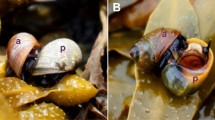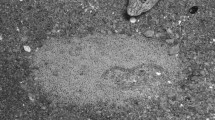Abstract
The level of reproductive isolation and reproductive characteristics were examined in sympatric populations of the northern and southern forms ofLethenteron reissneri, in the Ushiwatari Stream, a tributary of the Gakko River, Yamagata Prefecture, Japan, to elucidate the reproductive isolating mechanisms existing between them. Extensive allozyme data showed no gene exchange between the two forms in the study area, evidence of their strict reproductive isolation from each other. The spawning seasons overlapped between the northern and southern forms, the spawning period of the latter being slightly later than that of the former. The size at maturity also overlapped between the two forms, although the southern form indicated significantly larger in average size than the northern one. These results suggested that neither seasonal reproductive isolation nor size assortative mating occurred. On the other hand, the nesting assemblages were observed to comprise only males and females of each respective form, suggesting that a recognition system restricted to each form may operate as a premating isolating mechanism.
Similar content being viewed by others
Literature Cited
Beamish, R. J. and C. M. Neville. 1992. The importance of size as an isolating mechanism in lampreys. Copeia, 1992: 191–196.
Dobzhansky, T. 1937. Genetics and the origin of species. Columbia University Press, New York, 364pp.
Futuyma, D. J. 1998. Evolutionary Biology, 3rd. eds. Sinauer Associates, Inc., Massachusetts. 763 pp.
Giller, P. S. and B. Malmqvist. 1998. The biology of streams and rivers. Oxford University Press, New York, 296pp.
Gerhardt, H. C., M. B. Ptacek, L. Barnett and K. G. Torke. 1994. Hybridization in the diploid-tetraploid treefrogsHyla chrysoscelis andHyla versicolor. Copeia, 1994: 51–59.
Hardisty, M. W. and I. C. Potter. 1971a. The general biology of adult lampreys. Pages 127–206in M. W. Hardisty and I. C. Potter, eds The Biology of Lampreys, Vol. 1. Academic Press, London.
Hardisty, M. W. and I. C. Potter. 1971b. Paired species. Pages 249–277in M. W. Hardisty and I. C. Potter, eds. The Biology of Lampreys, Vol. 1. Academic Press, London.
Huggins, R. J. and A. Thompson. 1970. Communal spawning of brook and river lampreys,Lampetra planeri Bloch andLampetra fluviatilis L. J. Fish Biol., 2: 53–54.
Iwata, A. 1989. Petromyzontidae. Pages 33–40in H. Kawanabe and N. Mizuno, eds. Freshwater fishes of Japan. Yamatokeikokusha, Tokyo. (In Japanese).
Iwata, A., A. Goto and K. Hamada. 1985. A review of the Siberian lamprey,Lethenteron kessleri, in Hokkaido, Japan. Bull. Fac. Fish. Hokkaido Univ., 36: 182–190.
Larsen, L. O. 1980. Physiology of adult lampreys, with special regard to natural starvation, reproduction, and death after spawning. Can. J. Fish. Aquat. Sci., 37: 1762–1779.
Malmqvist, B. 1983. Breeding behavior of brook lampreysLampetra planeri: experiments on mate choice. Oikos, 41: 43–48.
Malmqvist, B. 1986. Reproductive ecology of lampreys. Indo-Pacific fish biology. Pages 20–30in T. Uyeno, R. Arai, T. Taniguchi and M. Matsuura, eds. Proceedings of the second international conference on Indo-Pacific fishes. Ichthyological Society of Japan, Tokyo.
Maruyama, T. 1981. Comparative ecology on the fluvial forms ofSalmo (Oncorhynchus) masou masou (Brevoort) andSalvelinus leucomaenis (Pallas) (Pisces, Salmonidae)-I-Structure of spawning redds and spawning sites in Kamidani. River Yura. Japan. J. Ecol., 31: 269–284. (In Japanese with English summary).
Mayr, E. 1963. Animal species, and evolution Harvard University Press, Cambridge, 797 pp.
Mayr, E. and P. D. Ashlock. 1991. Principles of systematic zoology. 2nd eds McGraw-Hill, Inc. New York. 475 pp.
Matsui, M. and T. Utsunomiya. 1983. Mating call characteristics of the frogs of the subgenusBabina with reference to their relationship withRana adenopleura. J. Herpetol., 17: 32–37.
Mousseau, T. A. and D. J. Howard. 1998. Genetic variation in cricket calling song across a hybrid zone between two sibling species. Evolution, 52: 1104–1110.
Paterson, H. E. H. 1985. The recognition concept of species. Pages 21–29in E. S. Vrba, ed. Species and Speciation, Transvaal Museum Monograph No. 4, Pretoria. 176 pp.
Sokolov, L. I., Y. A. Tsepkin and Y. R. Barabanova. 1992. Reproductive ecology of the western brook lamprey.Lampetra planeri (Petromyzontidae). J. Ichthyol., 32: 145–150.
Teeter, J. 1980. Pheromone communication in sea lamprey (Petromyzon marinus): implications for population management. Can. J. Fish. Aquat. Sci. 37: 2123–2132.
Wells, M. M. and C. S. Henry. 1992a. Behavioral responses of green lacewings (Neuroptera: Chrysopidae:Chrysoperla) to synthetic mating songs. Anim. Behav., 44: 641–652.
Wells, M. M. and C. S. Henry. 1992b. The role of courtship songs in reproductive isolation among populations of green lacewings of the genusChrysoperla (Neuroptera: Chrysopidae). Evolution, 46: 31–43.
Wells, M. M. and C. S. Henry. 1998. Songs, reproductive isolation, and speciation in cryptic species of insects, a case study using green lacewings. Pages 217–233in D. J. Howard and S. H. Berlocher, eds. Endless forms, species and speciation. Oxford University Press, New York.
Yamazaki, Y. and A. Goto. 1996. Genetic differentiation ofLethenteron reissneri populations, with reference to the existence of discrete taxonomic entities. Ichthyol. Res., 43: 283–299.
Yamazaki, Y. and A. Goto, 1997. Morphometric and meristic characteristics of two groups ofLethenteron reissneri. Ichthyol. Res., 44: 15–25.
Yamazaki, Y., and A. Goto. 1988. Ganetic structure and differentiation of fourLethenteron taxa from the Far East, deduced from allozyme analysis. Env. Biol. Fish., 52: 149–161.
Yamazaki, Y. and A. Goto. 2000. Present status and perspecitives on the phylogenetic systematics and speciation of lampreys. Japan. J. Ichthyol., 47: 1–28. (In Japanese with English summary.)
Author information
Authors and Affiliations
About this article
Cite this article
Yamazaki, Y., Goto, A. Breeding season and nesting assemblages in two forms oflethenteron reissneri, with reference to reproductive isolating mechanisms. Ichthyological Research 47, 271–276 (2000). https://doi.org/10.1007/BF02674250
Received:
Revised:
Accepted:
Published:
Issue Date:
DOI: https://doi.org/10.1007/BF02674250




